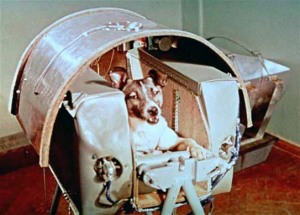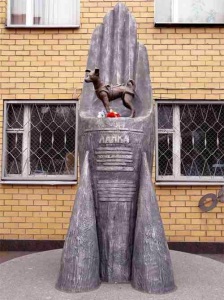On this day, Nov. 3, in 1957, the Soviet Union launched from Baikonur Cosmodrome the first-ever living animal into orbit: a dog named Laika.
Laika, whose name means “barker”, was a 3-year-old mongrel stray wandering the streets of Moscow when she was picked up and taken to a secret Soviet space laboratory. Scientists selected strays because they had already learned to adapt to cold and harsh conditions.
Along with two strays named Albina and Muska, Laika was put through a series of rigorous tests to prepare for spaceflight. The dogs were placed in centrifuges where they were subjected to the g-forces associated with launches. They were also kept in a series of progressively smaller cages to simulate the space capsule they would ride in. In the end, Laika was deemed most fit to become the first dog in space. The selection would have tragic consequences for the friendly stray.
She was placed in her restrictive module several days in advance and then right before launch, she was covered in a alcohol solution and painted with iodine in several spots so that sensors could be placed on her. The sensors were to monitor her heartbeat, blood pressure, and other bodily functions to better understand any physical changes that might occur in space.
On November 3, 1957, Sputnik 2 launched from Baikonur Cosmodrome successfully reached space. The spacecraft, with Laika inside, began to orbit the earth. Soon after, the Soviet Union announced that a recovery plan had not been established for Laika. With only three weeks to create the new spacecraft, they did not have time to create a way for Laika to make it home. Laika will die in space.
Laika’s heart rate, which was 103 beats per minute prior to launch, more than doubled to 240 beats per minute as the rocket accelerated toward orbit. Her heart rate finally settled down three hours into the flight. The first dog in space was alive and eating her food during her early hours in orbit. However, all signs of life ceased about five to seven hours after liftoff. Laika had died of excessive heat and stress.
The spacecraft continued to orbit the earth with all its systems off until it reentered earth’s atmosphere on April 14, 1958 and burned up on reentry.
Laika proved that it was possible for a living being to enter space. Her death also sparked animal rights debates across the planet. In the Soviet Union, Laika and all the other animals that made space flight possible are remembered as heroes. Laika is honored with a statue that sits in Star City, where Russian cosmonauts train.



que triste